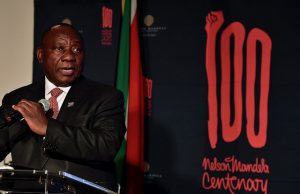
A R400-billion infrastructure fund to finance investment in critical infrastructure at national, provincial and local levels, was announced by President Cyril Ramaphosa on 21 September.
SANRAL welcomes the government’s emphasis on infrastructure as a primary driver for economic growth and job creation. Local and international investors take the quality of a country’s primary road network into consideration when they make decisions on where to establish projects that will stimulate broader growth and development.
National and provincial roads as well as infrastructure relating to human settlements and public transport will be among the top funding priorities.
The funds will go towards “shovel-ready infrastructure projects” – especially in the areas of roads and dams, President Ramaphosa said in a major policy speech at the Union Buildings.
This investment – the South African Infrastructure Fund – will be funded through the reprioritisation of existing government spending as well as resources coming from development finance banks and institutions and private sector investors.
The new plan is different from previous government initiatives because it is linked to implementation and specific timelines to ensure “projects are delivered on time and within budgets.”
A dedicated Infrastructure Execution Team has been created within the Presidency – consisting of people with extensive project management and engineering expertise to assist with project design and oversee implementation. The team will implement lessons learnt from the massive roll-out of infrastructure prior to the 2010 World Cup.
The role of the Presidential Infrastructure Commission will be strengthened to ensure improved coordination across the three spheres of government. This will “reduce the current fragmentation of infrastructure spend and ensure more efficient and effective use of resources.”
The private sector will also be invited “to enter into meaningful partnerships with government in this fund.”
Potential for job creation through investment
The President said infrastructure expansion and maintenance has the potential to create jobs on a large scale, attract investment and lay a foundation for sustainable economic expansion.
Details about the reprioritisation of revenue within the existing budget will be provided by the Minister of Finance, Nhlanhla Nene in his Medium-Term Budget Framework to be delivered in Parliament in October.
The contribution from the Fiscus will be more than R400-billion. This will then be used to leverage additional resources from developmental financial institutions, multilateral development banks, private lenders and investors.
The infrastructure investment is at the core of a comprehensive “economic stimulus and recovery plan” announced by Mr Ramaphosa which consists of –
- Growth enhancing economic reforms
- The reprioritisation of public funding to support job creation
- The establishment of the Infrastructure Fund
- Addressing urgent and pressing matters in education and health
- Investments in municipal social infrastructure improvement.
“These measures will be implemented immediately to ignite economic growth, restore investor confidence, prevent further job losses, create new jobs and address urgent challenges faced by vulnerable groups in the community,” he said.
He expressed his confidence that the new economic stimulus and recovery package will play a decisive role in reversing the current contraction in the South African economy.
Construction projects that are already being implemented by SANRAL will fit in seamlessly with other initiatives designed to attract investment from the private sector and develop finance banks. They are well-structured and well-managed, and SANRAL has a proven reputation of working in partnerships with the private sector.
- In the Eastern Cape work on the N2 Wild Coast Road is well underway including the construction of two of the largest bridges in Africa, across the Mtentu and Msikaba gorges. This development will boost tourism, stimulate trade and facilitate access to services in one of the most underdeveloped regions of the country. Contracts to the value of more than R2.7bn have been earmarked for small and black-owned enterprises.
- Construction on the Moloto Road has already started and some R4.5bn is allocated to this project in the current financial year. It includes major safety upgrades to a road that connects rural communities in Limpopo and Mpumalanga to the core of the Gauteng economy.
- The Mt Edgecombe interchange near Durban will be officially opened in October. This R900m project will provide improved access to tourism, agri-processing and commercial activities on the North Coast of KwaZulu-Natal.
- The N7 is a vital artery for economic development in both the Northern and Western Cape. It connects the Cape Peninsula with Namibia and feeds economic activity along the entire West Coast. Current upgrades between Hopefield and Melkbosstrand represents a R2.3bn investment in infrastructure in the region.

